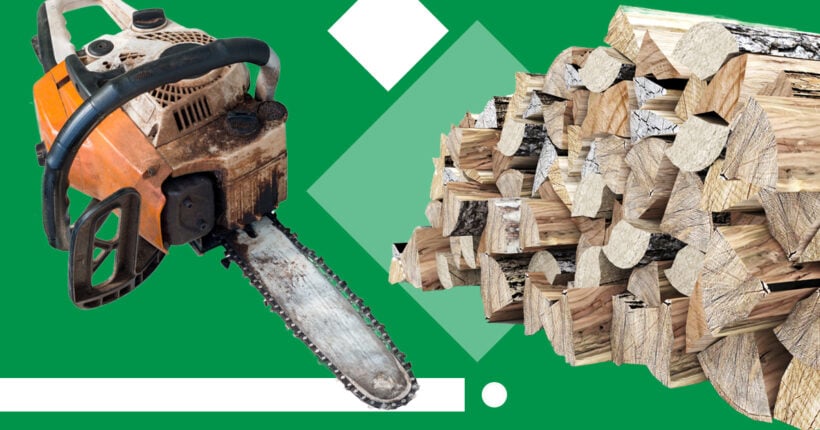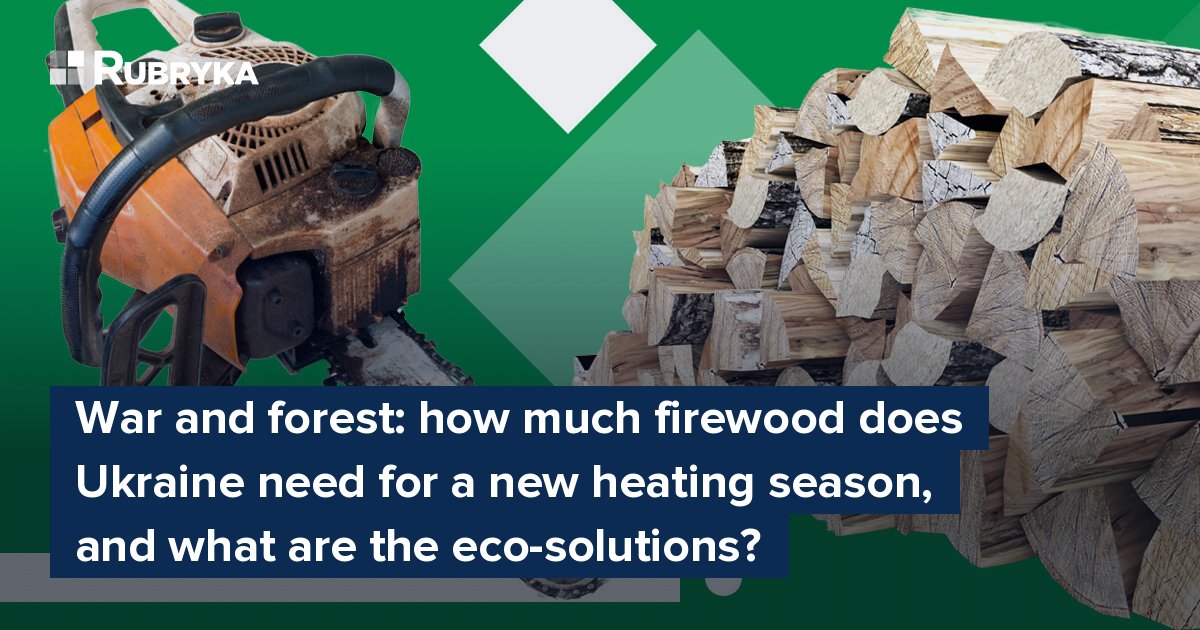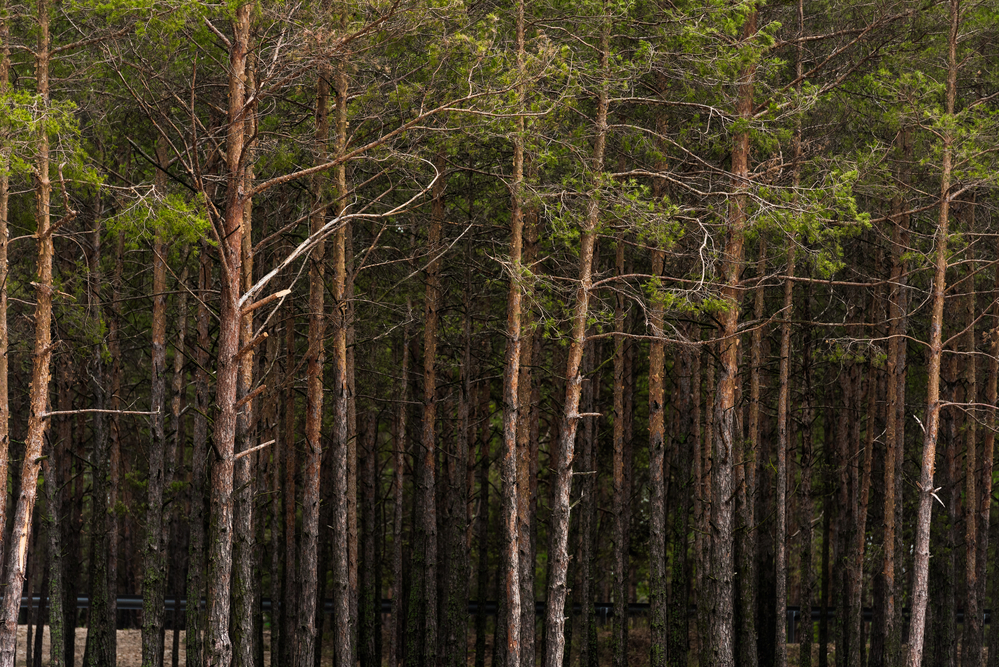
Фото: Рубрика
What is the problem?
putin has already started an energy war against Europe and will probably try to leave Ukrainian cities without heat in the winter by targeting the infrastructure.
In previous articles, we wrote about modular mobile boiler houses that work on different fuel types and can be quickly connected instead of damaged equipment. The government has already allocated funds to purchase many such boiler houses.
It is a timely and far-sighted decision, but a sufficient amount of alternative fuel—coal, firewood, straw, etc.—is needed to provide mobile boiler houses. Environmental monitoring expert Maksym Soroka noted that emissions into the air due to the use of such types of fuel would increase many times and said that we have no other worthy alternative. According to him, it is a secondary effect of the war, which consists, first, of an increase in harmful air emissions, and second, of an increase in the felling of forests.

Not to freeze in winter, we need more than 7 million cubic meters of forest
If we can talk about the increase in emissions only in winter, then the increase in the felling of forests has already started. The State Forestry Agency has already collected applications for firewood supply from almost all regions of the country. The total volume of the declared need is more than 7 million cubic meters. It is several times more than Ukrainian consumers usually use during the heating season. Only Donetsk, where the destruction of infrastructure is the greatest, needs more than 700,000 cubic meters. The Mykolaiv region needs more than 400,000 cubic meters, and the Odesa region requires more than 300,000 cubic meters.
Increasing firewood harvesting is not so easy. The forest is our natural asset, which must be protected by law, and simply "letting it fall under the ax" will not work. We must adhere to the principle of sustainable forest management, which means not taking more resources from the forest than can be restored in the same period.
It is a difficult task. But there is a solution.
What is the solution?
Ukraine underutilizes its forest resources
The State Forestry Agency explains this unexpected fact: according to experts' calculations, on average, about four cubic meters of wood grows per hectare of forest (6-7 cubic meters in the Carpathians, 2-3 cubic meters in the southern regions). The area of Ukrainian forests is approximately 10 million hectares, so 40 million cubic meters of wood appear annually. Only half—20 million cubic meters—is gathered. And what about another resource? It grows old, dries up, dies, falls, and rots. These are mainly hard-to-reach areas in the mountains, swampy areas, etc. So, the first solution is the reserve, which is not gathered due to insufficiently developed forest infrastructure. According to preliminary estimates, it is an additional 2 million cubic meters of firewood.
The second possibility of increasing logging is to intensify forest care. In 2020, the normative indicator of plantings being complete, i.e., the density of trees in the forest, was reduced in Ukraine. Accordingly, there was an opportunity to increase the thinning volume and advance felling (forest care). According to the calculations of our experts, this will provide an opportunity to log another 4 million cubic meters of firewood.
Third, substantial reserves of sanitary felling and colossal wood chips resources exist, so millions of tons of waste are left in the forest. Approximately 300,000 cubic meters are used for processing, so another one and a half million cubic meters of wood chips remain. According to the head of the State Agency of Forest Resources of Ukraine, Yurii Bolokhovets, the State Forestry Agency is ready to invest in recycling and process the entire volume if boiler plants agree to buy this fuel.
Therefore, the forest industry is ready to find the necessary amount of firewood for the country without harming the forest fund. The State Forestry Agency notes that a meeting with the chief engineers of the regional offices has already been held, and the process of allocating additional plantations for harvesting continues.

Will it work?
But logging is only part of the issue. Firewood was always bought mainly by residents or communities. They purchased from local forestry farms, and everything happened at the local level. There was no established distribution and delivery system to other regions because we did not need this. But this year, we will have to move hundreds of thousands of cubic meters of firewood from the country's west to the regions most affected by the war. We create strategic "emergency" reserves on the ground and distribute fuel between household consumers and utility companies, so some logistical issues arise.
Today, the south and east forest farms don't have enough resources to provide the colossal fuel needs of local housing and utility services. russia having destroyed gas networks and boiler houses caused such conditions, so it is appropriate for the authorities at the regional level to consider centralized procurement and a resource distribution system on the ground.
Another vital aspect is transportation tariffs. Forest farms will provide a resource for the affected regions at affordable prices. At the same time, the delivery of pine firewood by rail from the Volyn region to the Mykolaiv region will almost triple the cost of a cubic meter of firewood. Therefore, the State Forestry Agency is catching up: it is essential to set up system supplies today without waiting for hyped demand on the eve of the heating season in October-November. In addition, it is necessary to consider that wood prices are increasing.
Environmentalists are also against the logging of "excess" raw materials. We asked a biologist from the Ukrainian Nature Protection Group, Yehor Hrynnyk, about how safe the proposed methods of logging wood are for the environment.
So, where is the solution?
The first decision of the State Forestry Agency is a general increase in forest felling. Yehor Hrynnnyk believes that the intention to increase the amount of felling, which both the head of the State Forest Resources Agency and the minister of ecology are talking about, is a disturbing story.
"First, no one knows for sure how much wood grows in Ukraine and how much is actually cut down. A high-quality and honest inventory of forests hasn't been conducted yet. At the same time, the volume of shadow logging can reach millions of cubic meters, although no one counted this either. Under such conditions, it is generally impossible to say that Ukraine is underutilizing some resources.
In general, a forest is not just cubic meters of wood. Even if European countries cut down more (which, as I said above, is inaccurate), it does not mean we have to emulate them. Due to large volumes of logging, many European countries have turned their forests from full-fledged natural ecosystems into plantations drying up in the face of climate change. They have already admitted their mistake. For some reason, our government wants to step on the same rake," says the expert.
Yehor draws attention to the fact that previously forest farms were not interested in selling firewood to the population or social institutions.
"Because the price is low, there are few opportunities for manipulation. Therefore, in many Ukrainian forestry farms, firewood piles remain after felling, which foresters do not want to take out of the forest. They are rotting there, and new fellings are already underway somewhere nearby," he explains. But the situation may change for the better. With the increase in wood prices, interest in selling it to the population will grow among foresters. "Surplus" wood that was not used before will appear.

Which forests can be cut down and why?
The second decision of the State Forestry Agency was the most criticized by the environmentalist.
"Cutting down 'hard-to-reach and swampy forests' is environmental suicide," says Yehor Hrynnyk. "This is the destruction of the remains of Ukraine's most valuable natural forests, which haven't been reached by the farm hand of foresters yet. Such destruction is already happening. Europe tries to protect such forests as the apple of an eye. Ukraine lets them turn to firewood."
However, given Ukraine's urgent need for fuel, as Maksym Soroka points out, people's needs come first. Environmental damage is the second issue in critical conditions. Besides, it is too early to say that "all is lost." According to Yehor Hrynnyk, artificial monoculture forests, already prone to extinction because they are not a sustainable ecosystem, can be an alternative place for felling wood. The same applies to the decision of the State Forestry Agency about intensifying forest care and thinning forest density:
"It's OK if maintenance takes place in artificial forests that need it and not in the remnants of old natural forests," says the expert.
What can be the solution right now?
- You don't need to burn wood; burn pellets. This fuel is made from "waste": sunflower husks, inedible parts of agricultural plants, and straw. Some pellets are also made from waste left after wood processing with bark and sawdust.
Compulsions can release the same amount of thermal energy during combustion as coal but with a lower level of carbon dioxide.
This method is suitable for those who have even an ordinary stove in a private house. However, the most effective way to use pellets is to install a basket in the stove's furnace, which prevents capsules that have not entirely burned out from falling into the ashtray. You can find instructions on how to install a pellet burner here.
- Individual convection heaters. They work on electricity and are considered one of the cheapest heating methods. They are installed in rooms under windows and sometimes look even better than ordinary batteries: like a ceramic plate or a tubular panel. For those who don't plan repairs, there are mobile heaters.
- If you burn wood, buy legally cut wood. You can do this in forestry. For this, contact the nearest forestry farm, and make sure you will most likely have to transport the wood yourself.
The State Agency of Forest Resources is also announcing a new online resource, DrovaYe, through which you can buy wood. The launch is planned before the beginning of the heating season.
Newsletter
Digest of the most interesting news: just about the main thing










